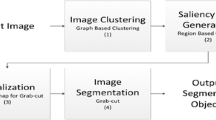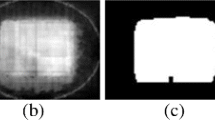Abstract
Salient objects extraction from a still image is a very hot topic, as it owns a lot of useful applications (e.g., image compression, content-based image retrieval, digital watermarking). In this paper, targeted to improve the performance of the extraction approach, we propose a two step salient objects extraction framework based on image segmentation and saliency detection (TIS). Specially, during the first step, the image is segmented into several regions using image segmentation algorithm and the saliency map for the whole image is detected with saliency detection algorithm. In the second step, for each region, some features are extracted for the SVM algorithm to classify the region as a background region or a salient region twice. Experimental results show that our proposed framework can extract the salient objects more precisely and can achieve a good extraction results, compared with previous salient objects extraction methods.










Similar content being viewed by others
References
Achanta R, Hemami S, Estrada F, Susstrunk S (2009) Frequency-tuned salient region detection. In: Proc. of IEEE computer vision and pattern recognition (CVPR), pp 1597–1604
Daubechies I (1990) The wavelet transform, time-frequency localization and signal analysis. IEEE Trans Info Theory 6(5):961–1005
Felzenszwalb P, Huttenlocher D (2004) Efficient graph-based image segmentation. Int J Comput Visn (IJCV) 59(2):167–181
Goferman S, Manor LZ, Tal A (2010) Context-aware saliency detection. In: Proc. of IEEE computer vision and pattern recognition (CVPR), pp 2376–2383
Han Z, Li Z, Zhi ZY (2009) Salient object extraction based on region saliency ratio. In: Proc. of the eigth IEEE/ACIS international conference on computer and information science
Harel J, Koch C, Perona P (2007) Graph-based visual saliency. In: Proc. of advances in neural information processing systems (NIPS), vol 19, pp 545–552
Hou X, Zhang L (2007) Saliency detection: a spectral residual approach. In: Proc. of IEEE computer vision and pattern recognition (CVPR), pp 1–8
Itti L, Koch C, Niebur E (1998) A model of saliency-based visual attention for rapid scene analysis. IEEE Trans Pattern Anal Mach Intell 2(11):1254–1259
Kim S, Park S, Kim M (2003) Central object extraction for object-based image retrieval. In: Proc. of the international conference on image and video retrieval, pp 3949
Kwak S, Ko B, Byun H (2004) Automatic salient-object extraction using the contrast map and salient points. In: Proc. of PCM (2), pp 138–14
Levinshtein A, Stere A (2009) TurboPixels: fast superpixels using geometric flows. IEEE Trans Pattern Anal Mach Intell 31(12):2290–2297
Lowe DG (2004) Distinctive image features from scale-invariant keypoints. Int J Comput Vis 60(2):91–110
Ma YF, Zhang HJ (2003) Contrast-based image attention analysis by using fuzzy growing. In: Proc. of the eleventh ACM international conference on multimedia table of contents, pp 374–381
Muller KR, Mika S et al (2001) An Introduction to kernel-based learning algorithm. IEEE Trans Neural Net 12(2):181–201
Osberger W, Naeder AJ (1998) Automatic identification of perceptually important regions in an image. In: Proc. of the IEEE international conference on pattern recognition, pp 701–704
Park KT, Moon YS (2007) Automatic extraction of salient objects using feature maps. In: Proc. of the IEEE international conference on acoustics, speech and signal processing (ICASSP)
Pawes MA, Tenht WR (1999) Partitioning 3D surface meshes using watershed segmentation. IEEE Trans Vis Comput Graph 5(4):308–321
Shi J, Malik J (2000) Normalized cuts and image segmentation. IEEE Trans Pattern Anal Mach Intell 22(8):888–905
Suykens JAK, Vandewalle J (1999) Least squares support vector machine classifiers. Neural Process Lett 9(3):293–300
Tang C et al (1993) Texture analysis and classification with tree-structured wavelet transform. IEEE Trans Image Process 2(4):429–441
Wang W, Song Y, Zhang A (2002) Semantics retrieval by region saliency. In: Proc. of the international conference on image and video retrieval, pp 2937
Zhang J, Zhuo L, Shen LS (2008) Regions of interest extraction based on visual attention model and watershed segmentation. IEEE International Conference on Neural Networks & Signal Processing, pp 375–378, Zhenjiang, China
Acknowledgements
This work was supported by “the Fundamental Research Funds for the Central Universities” (2012JBM032). Tao Han’s research was supported by Hubei Provincial Science and Technology Department (Grant No.: 2011BFA004).
Author information
Authors and Affiliations
Corresponding author
Rights and permissions
About this article
Cite this article
Liu, Q., Han, T., Sun, Y. et al. A two step salient objects extraction framework based on image segmentation and saliency detection. Multimed Tools Appl 67, 231–247 (2013). https://doi.org/10.1007/s11042-012-1077-1
Published:
Issue Date:
DOI: https://doi.org/10.1007/s11042-012-1077-1




